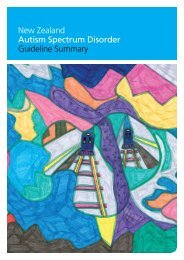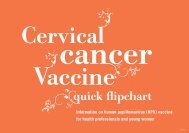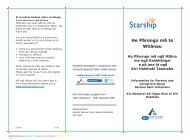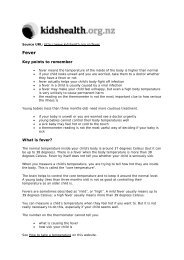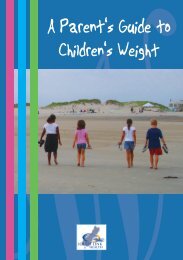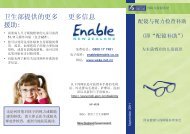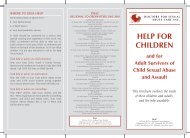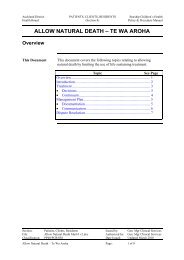New Zealand Autism Spectrum Disorder Guideline - Ministry of Health
New Zealand Autism Spectrum Disorder Guideline - Ministry of Health
New Zealand Autism Spectrum Disorder Guideline - Ministry of Health
Create successful ePaper yourself
Turn your PDF publications into a flip-book with our unique Google optimized e-Paper software.
Glossary<br />
Social decision-making<br />
strategies<br />
Social model <strong>of</strong><br />
disability<br />
Social skill repertoire<br />
Social skills groups<br />
Social stories<br />
Social validity<br />
Son-Rise<br />
Special Education<br />
Needs Coordinator<br />
(SENCO)<br />
Specialised curriculum<br />
Speech<br />
Speech-language<br />
therapist (SLT)<br />
Splinter skills<br />
curriculum-based programme that targets self-control and social awareness<br />
skills, teaches an eight-step social decision-making strategy and incorporates<br />
practicing the skills in real life situations<br />
a model that describes disabling social, environmental and attitudinal<br />
barriers that people with disabilities face, rather than lack <strong>of</strong> ability on the<br />
part <strong>of</strong> the individual<br />
the set <strong>of</strong> social skills (positive appropriate social behaviours) that an<br />
individual possesses<br />
a number <strong>of</strong> individuals learning social skill strategies together<br />
narratives written about social situations to assist understanding, to help<br />
the person manage their anxiety and sometimes to encourage appropriate<br />
behaviour<br />
a skill or behaviour is said to have social validity if it leads to increased<br />
adaptive action alternatives for the individual such that he/she is likely<br />
to have access to more reinforcements, or is able to have better life<br />
circumstance/experiences, ie, that meets a practical or social need for<br />
this child and their family<br />
intensive training programme based on the idea that the best way to help a<br />
child with autism is to follow the child’s lead. Also known as the Options<br />
method.<br />
a person in schools who coordinates programmes for children with special<br />
education needs<br />
a curriculum which is tailored to meet the needs <strong>of</strong> the child with ASD. Such<br />
a curriculum usually emphasises social and communication skills.<br />
the act <strong>of</strong> speaking (or using verbal language)<br />
therapist trained to work with individuals to help them develop their<br />
communication skills using a range <strong>of</strong> techniques<br />
see savant skills<br />
Spontaneous<br />
communication<br />
Stereotypies<br />
unprompted communication<br />
persistent postural, gestural or verbal responses that are without apparent<br />
meaning and tend to recur inappropriately<br />
Glossary<br />
Stimming<br />
Structure<br />
Structured<br />
environments<br />
see self-stimulatory behaviours<br />
environments or activities can be structured, and this will increase clarity<br />
and predictability, and make it easier for people to negotiate their way<br />
around them successfully. When the curriculum or the expectations<br />
(activities, schedule and environment) are clear and comprehensible and<br />
predictable to both the students and observers.<br />
environments which are planned to ensure that students have a clear<br />
comprehensible programme and environment<br />
<strong>New</strong> <strong>Zealand</strong> <strong>Autism</strong> <strong>Spectrum</strong> <strong>Disorder</strong> <strong>Guideline</strong> 259



